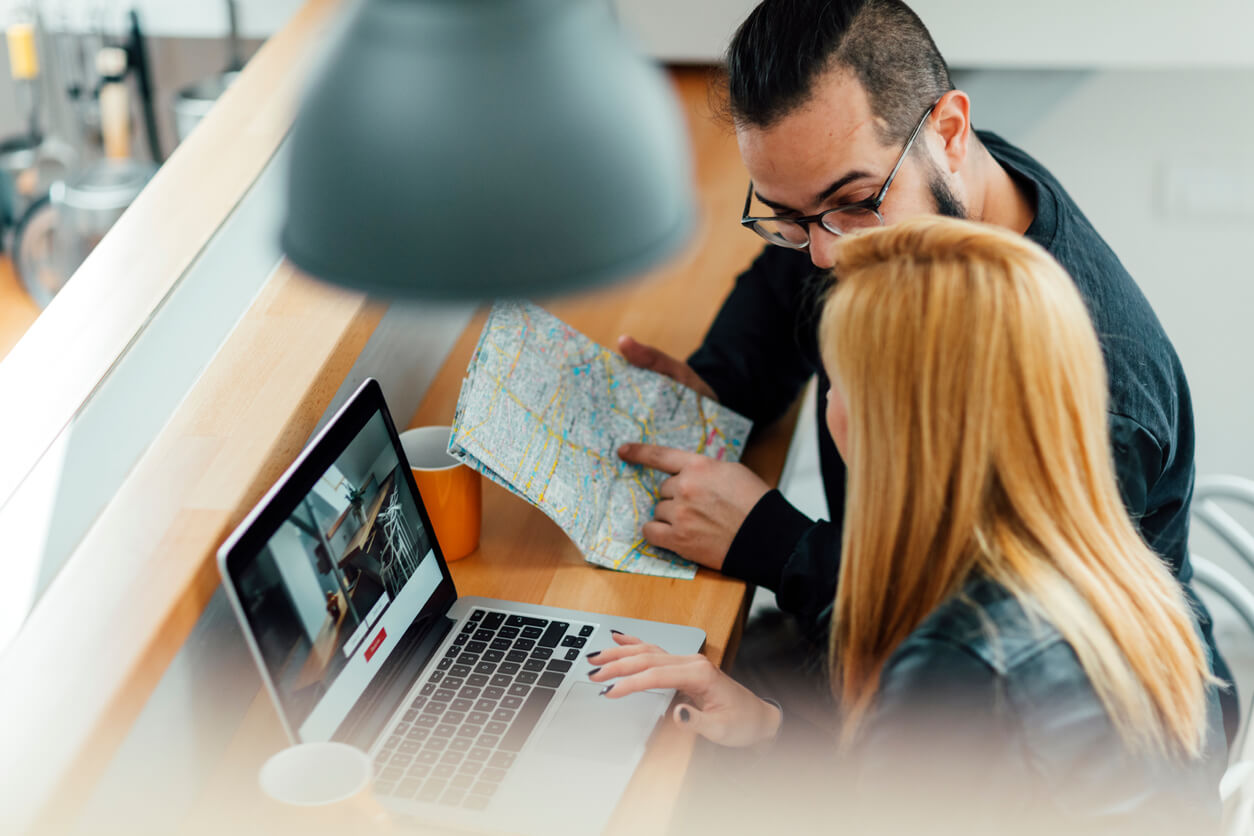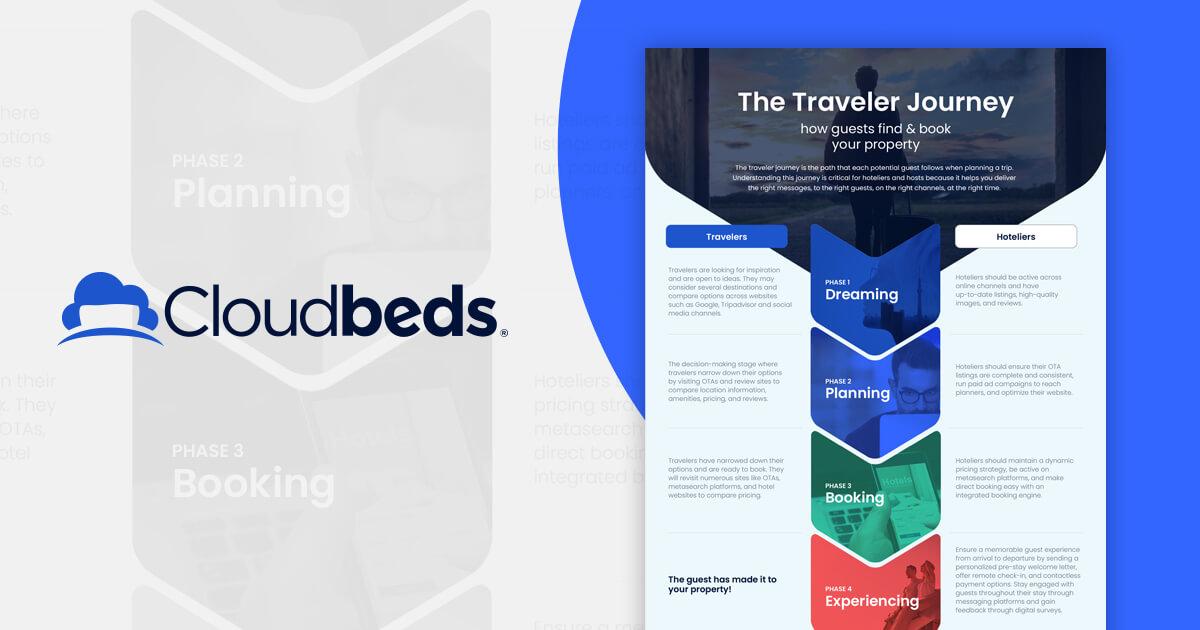
By Cloudbeds
When it comes to hotel marketing, the secret to driving more bookings is understanding how travelers arrive at your property in the first place. Where do they first find out about your hotel, hostel, inn, B&B, or vacation rental property? What information do they seek when planning a trip, what sites do they visit, and where do they book?
Only once you have answers to these questions will you really know where to find accommodation shoppers, how to entice them to choose your property, and how to set the stage for a positive guest experience.
What is the traveler’s journey?
The traveler’s journey, also called the customer decision journey, is the path people follow when planning a trip, from the inspiration stage right through to the post-stay travel experience. While it’s called a journey, it involves much more than travel; it also includes pre-arrival planning, the booking process, and post-trip sharing.
The traveler’s journey can be divided into several stages or phases, which are often referred to as dreaming, planning, booking, experiencing, and sharing. Each stage presents opportunities, or touchpoints, for hotels to connect with travelers, influence their decisions, and ensure their needs are met.
Understanding the traveler’s journey is critical to hoteliers and hosts because it helps you build your marketing plan, decide where to allocate resources, and make sure to deliver the right messages to the right guests on the right channels at every step. In turn, this helps drive more bookings, incremental revenue, and higher guest satisfaction.
The customer journey: A funnel or a circle?
Traditionally, marketers have used a purchase funnel model to illustrate the customer journey. In this model, the journey starts at the wide end of the funnel when buyers are just beginning the shopping process and considering a broad array of choices. As buyers move through the process, eliminating some and homing in on others, the funnel narrows. At the end of the funnel, the buyer purchases a product, and the journey ends.
But what happens after the purchase? Several years ago, McKinsey & Company put forth an alternative, circular model that encompasses the post-purchase stage and the cyclical nature of purchasing and repurchasing over a customer’s lifetime. This model features a “loyalty loop” that is highly applicable to the hotel business. When guests are happy with their accommodation choice, on their next trip they may skip the dreaming and planning stages and go straight to rebooking the same property.
What is a guest journey map?
Whether you prefer a funnel-shaped or circular model, it’s a good idea to create a guest journey map to illustrate the typical path your guests follow to find and book your property. This will help you visualize the key phases of the traveler’s journey and the potential touchpoints along the way for reaching travel planners.
Download the Traveler Journey Infographic:
The five stages of travel
Marketers use a variety of labels to describe the steps of the customer journey. For lodging operators, Google’s Five Stages of Travel can be particularly helpful. Below we explain what happens at each stage and how hotel marketers can connect with travelers and guide their choices at every touchpoint. Today, many of these touchpoints take place on digital channels. With the help of hospitality technology, hotels can automate tasks to save time and ensure opportunities aren’t missed.
Stage 1: Dreaming
In this initial stage, travelers are looking for inspiration. They are open to ideas and exploring a variety of options. They might be considering several destinations and comparing options for transportation, accommodation, and activities in each. In this stage search activity tends to be broad and destination-oriented, favoring platforms like Google, Tripadvisor, destination marketing organization (DMO) sites, and social media.
Marketing strategies for hoteliers and hosts in the Dreaming Stage:
- Make sure your Google Business Profile is accurate. Information from these listings is displayed in popular travel research products like Google Search, Google Hotel Search, and Google Maps and will help a traveler discover your property.
- Revisit your Tripadvisor listing to ensure the content is fresh and current.
- Ensure you’re listed on the websites of local, regional, and national destination marketing organizations or tourism bureaus.
- Your listings on each of these platforms should be complete and up to date with details about your location and amenities, quality photos and videos, and appealing descriptions that answer the questions travelers may have at this stage of the journey.
- Share photos, videos, and other content on Facebook, Instagram, and YouTube to promote your destination and local activities. Encourage your guests to do the same.
Stage 2: Planning
In this decision-making stage, travelers narrow down their options, selecting the destination and evaluating options for accommodations and activities. Online travel agencies (OTAs) and review sites are especially popular during this phase for comparing location information, amenities, pricing, and reviews. Travelers also check out hotel websites to find out more.
Marketing strategies for hoteliers and hosts in the Planning Stage:
- Diversify your distribution. The more channels you’re listed on, the better the chances travelers will find you. This includes not only the most popular OTAs but also metasearch engines, the GDS for travel agent bookings and other providers, and, if applicable, alternative accommodation sites like Airbnb, Homeaway, Vrbo, and Hostelworld. Use a channel manager to efficiently manage rates and availability on multiple sites.
- Ensure your OTA listings are complete with descriptions, photos, amenities, and other helpful information such as your wifi availability. The quality of your listings is important because it affects your ranking on OTA sites. The higher your quality score, the greater your visibility. It will also help conversion rates by giving travelers the information they seek.
- Respond to reviews promptly, fix issues that come up in complaints, and incentivize your team to earn five-star reviews. Traveler reviews and ratings also affect OTA rankings and can have a major impact on booking decisions. You want to make it clear that you care about your guests and that your property is equipped to fulfill travelers’ needs.
- Optimize your website. Content should be easy to navigate and SEO-optimized, with all the information site visitors, need to make a booking decision. It should also be mobile-friendly for an optimal user experience as 40% of U.S. travel site visits come from mobile. Make it easy to contact your property and respond quickly to inquiries.
- Focus on visual storytelling. Travel planners tend to scan text quickly and spend more time viewing photos and videos. Feature imagery captures the imagination, gives a sense of place, and inspires emotions like desire, nostalgia, relaxation, productivity, and a sense of fun.
- Make sure your digital marketing strategy includes a paid search campaign to reach travel planners with targeted ads on Google, Facebook, and Instagram.

Stage 3: Booking
Now, the moment of truth. Travelers have narrowed down the options to one property and are ready to make a booking. Will it be your property? During this phase, travelers tend to visit and revisit numerous sites like OTAs, metasearch platforms, and hotel websites to compare pricing and offers before they make their final choice.
Marketing strategies for hoteliers and hosts in the Booking Stage:
- Maintain a dynamic pricing strategy. Your goal is not just to sell rooms but to sell them at the highest rate travelers are willing to pay. This means constantly adjusting rates to reflect changes in market demand, occupancy, and competitor pricing. Revenue management software will help you optimize and automate this process, ensuring you always offer the right rates to the right guests at the right time.
- Play the metasearch game. Platforms like Google Hotel Search, Kayak and Trivago are especially popular at this stage for comparing prices across booking channels. A hotel metasearch marketing strategy will help you maintain rate parity across channels and compete with OTAs for bookings.
- Diversify your offerings. Offer a variety of room types and packages to appeal to a broad range of traveler types, from budget travelers and business travelers to attendees of special events and last-minute bookers. Remember that traveler preferences change over time.
- Make direct bookings easy. A fast and reliable hotel reservation system with an integrated booking engine will enable travelers to check availability and make a booking in real-time on your website using their credit card or other payment option. Offer a best-rate guarantee and incentives to book directly and limited-time offers to create a sense of urgency to book now.
- Send a confirmation to summarize the details of the guest’s stay using email automation software.
Stage 4: Experiencing
Your work doesn’t end with a booking; in some ways, it’s just beginning. This stage starts with the guest’s arrival and continues through to departure. Here there are opportunities for marketing as well as for enhancing the traveler experience.
Marketing strategies for hoteliers and hosts in the Experiencing Stage:
- Ensure a seamless arrival experience by sending an automated pre-stay email or welcome letter to invite the guest to start planning their stay. Include a special offer to upgrade the room, add breakfast, reserve a table in the dining room, or order an in-room amenity.
- Make the process easy for guests by offering remote check-in services and contactless payment options as well as the option to self-checkout.
- Use a messaging service to keep in touch with guests and send them important notifications during their stay on the channel of their choice, whether by text messaging, Facebook Messenger, or WhatsApp.
- Check in with guests partway through their stay using an in-stay survey solution. This will give you the opportunity to resolve issues while the guest is in-house and find ways to turn a good stay into an unforgettable experience.
Stage 5: Sharing
This stage begins after guests depart and continues through to their next trip when the traveler’s journey recommences. This is the time guests are most likely to share their experience with others through word-of-mouth, on social media, or in online reviews.
Marketing strategies for hoteliers and hosts in the Sharing Stage:
- Send an automated post-stay survey to solicit feedback or ask guests to post an online review on their travel site of choice.
- Invite guests to follow you on Facebook and Instagram and share photos and comments about their stay.
- Invite them to join your loyalty program to take advantage of special perks, rewards, and incentives.
- Send special offers to entice guests back and monthly newsletters to help keep your property top of mind.
And that brings us to the end of the traveler’s journey, although it’s certainly not the end of your relationship with the guest. If you’ve done a great job of communicating with guests and taking care of their needs at every touchpoint, they may bypass the Dreaming and Planning stages and go directly to rebooking your property on their next trip. The more guests who follow this loyalty loop, the more you will save in marketing costs, and the more long-time, loyal guests you will earn.









